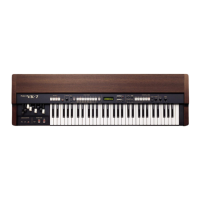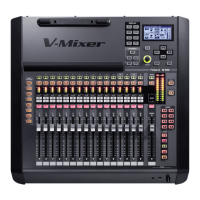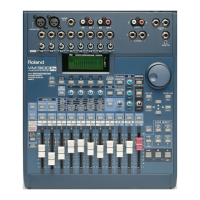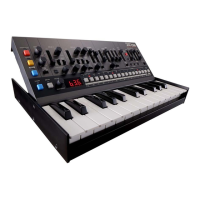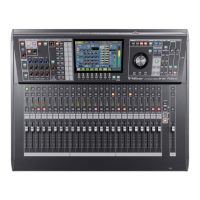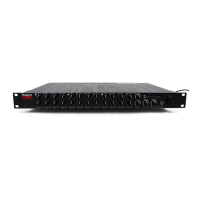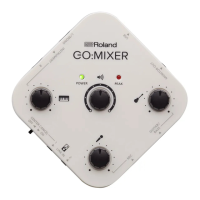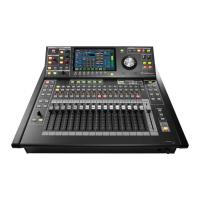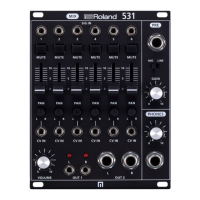30
MIDI Implementation
3. Supplementary Material
ÁDecimal and Hexadecimal Table
(Hexadecimal Numbers are Indicated by “H”)
In MIDI documentation, data values and addresses/sizes of exclusive messages etc. are
expressed as hexadecimal values for each 7 bits.
The following table shows how these correspond to decimal numbers.
D H D H D H D H
0 00H 32 20H 64 40H 96 60H
1 01H 33 21H 65 41H 97 61H
2 02H 34 22H 66 42H 98 62H
3 03H 35 23H 67 43H 99 63H
4 04H 36 24H 68 44H 100 64H
5 05H 37 25H 69 45H 101 65H
6 06H 38 26H 70 46H 102 66H
7 07H 39 27H 71 47H 103 67H
8 08H 40 28H 72 48H 104 68H
9 09H 41 29H 73 49H 105 69H
10 0AH 42 2AH 74 4AH 106 6AH
11 0BH 43 2BH 75 4BH 107 6BH
12 0CH 44 2CH 76 4CH 108 6CH
13 0DH 45 2DH 77 4DH 109 6DH
14 0EH 46 2EH 78 4EH 110 6EH
15 0FH 47 2FH 79 4FH 111 6FH
16 10H 48 30H 80 50H 112 70H
17 11H 49 31H 81 51H 113 71H
18 12H 50 32H 82 52H 114 72H
19 13H 51 33H 83 53H 115 73H
20 14H 52 34H 84 54H 116 74H
21 15H 53 35H 85 55H 117 75H
22 16H 54 36H 86 56H 118 76H
23 17H 55 37H 87 57H 119 77H
24 18H 56 38H 88 58H 120 78H
25 19H 57 39H 89 59H 121 79H
26 1AH 58 3AH 90 5AH 122 7AH
27 1BH 59 3BH 91 5BH 123 7BH
28 1CH 60 3CH 92 5CH 124 7CH
29 1DH 61 3DH 93 5DH 125 7DH
30 1EH 62 3EH 94 5EH 126 7EH
31 1FH 63 3FH 95 5FH 127 7FH
D: decimal
H: hexadecimal
* Decimal expressions used for MIDI channel, bank select, and program change are 1
greater than the decimal value shown in the above table.
* Hexadecimal values in 7-bit units can express a maximum of 128 levels in one byte of
data. If the data requires greater resolution, two or more bytes are used. For example,
a value indicated by a hexadecimal expression in two 7-bit bytes aa bbH would be
aa x 128 + bb.
* Data marked “nibbled” is expressed in hexadecimal in 4-bit units. A value expressed
as a 2-byte nibble 0a 0bH has the value of a x 16 + b.
<Example 1>
What is the decimal expression of 5AH?
From the preceding table, 5AH = 90
<Example 2>
What is the decimal expression of the value 12 34H given as hexadecimal for each 7
bits?
From the preceding table, since 12H = 18 and 34H = 52
18 x 128 + 52 = 2356
ÁExample of an Exclusive Message and
Calculating a Checksum
Roland Exclusive messages are transmitted with a checksum at the end (before F7)
to make sure that the message was correctly received. The value of the checksum is
determined by the address and data (or size) of the transmitted exclusive message.
À How to Calculate the Checksum
(Hexadecimal Numbers are Indicated by “H”)
The checksum is a value that produces a lower 7 bits of zero when the address, size,
and checksum itself are summed. If the exclusive message to be transmitted has an
address of aa bb ccH and the data is dd ee H, the actual calculation would be as
follows:
aa + bb + cc + dd + ee + = sum
sum / 128 = quotient ... remainder
128 - remainder = checksum
(However, the checksum will be 0 if the remainder is 0.)
<Example>
When setting PGM Select to INPUT 2 for data set 1
From the “Parameter Address Map”, the address of the PGM Select is 00H 0FH 00H and
the INPUT 2 parameter is 18H. Therefore ...
F0H 41H 10H 00H 00H 00H 00H 2CH 12H 00H 0FH 00H 18H ??H F7H
(1) (2) (3) (4) (5) (6) (7) (8) (9)
(1) Exclusive Status
(2) ID Number (Roland)
(3) Device ID
(4) Model ID
(5) Command ID (DT1)
(6) Address
(7) Data
(8) Checksum
(9) EOX
Next calculate the checksum. Add (6) to (7).
00H + 0FH + 00H + 18H = 0 + 15 + 0 + 24 = 39 (sum)
39 (sum) / 128 = 0 (quotient) ... 39 (remainder)
Checksum = 128 - 39 (remainder) = 89 = 59H
Thus, the message to transmit is :
F0H 41H 10H 00H 00H 00H 00H 2CH 12H 00H 0FH 00H 18H 59H F7H
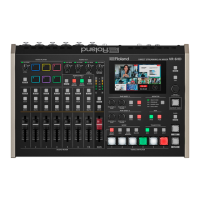
